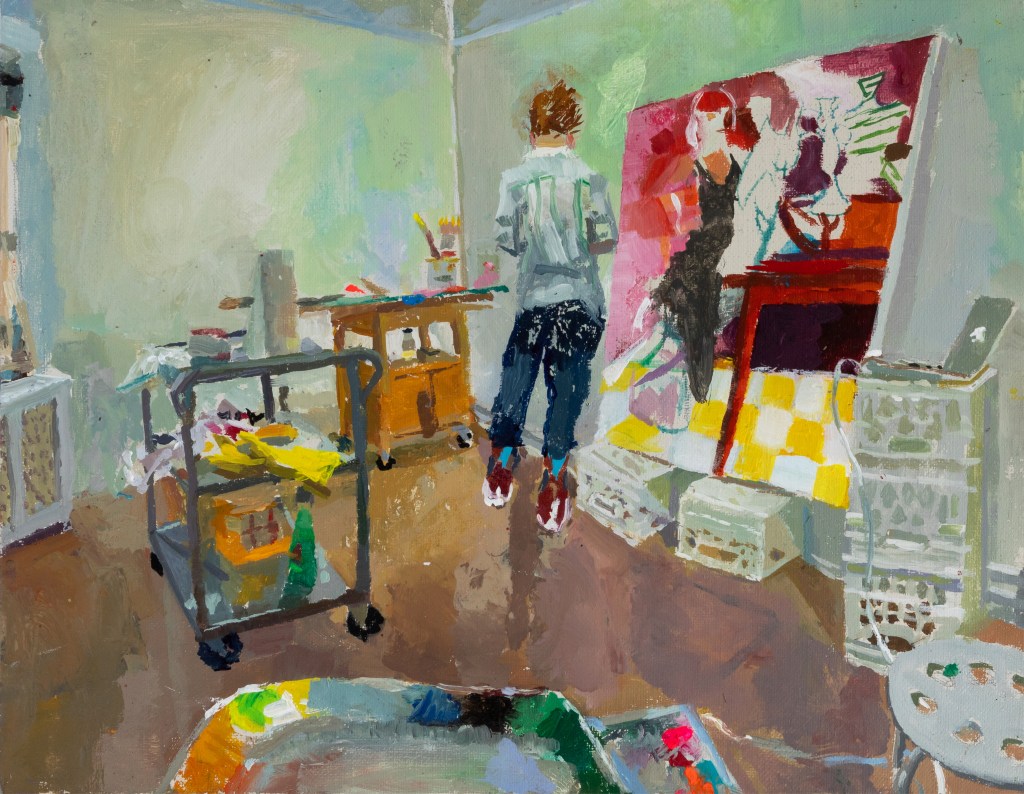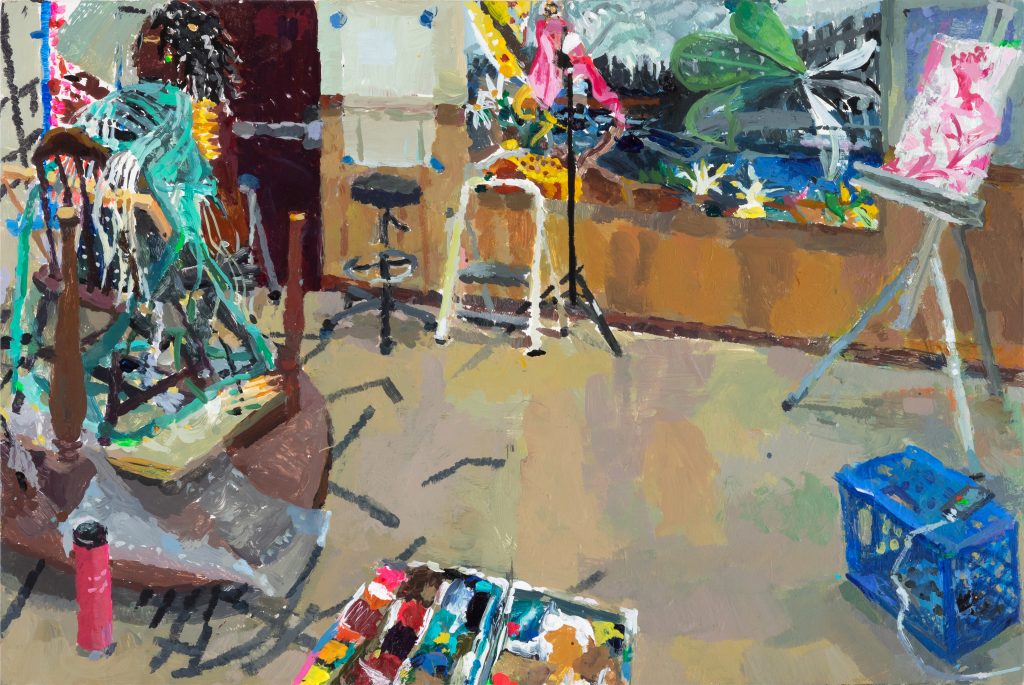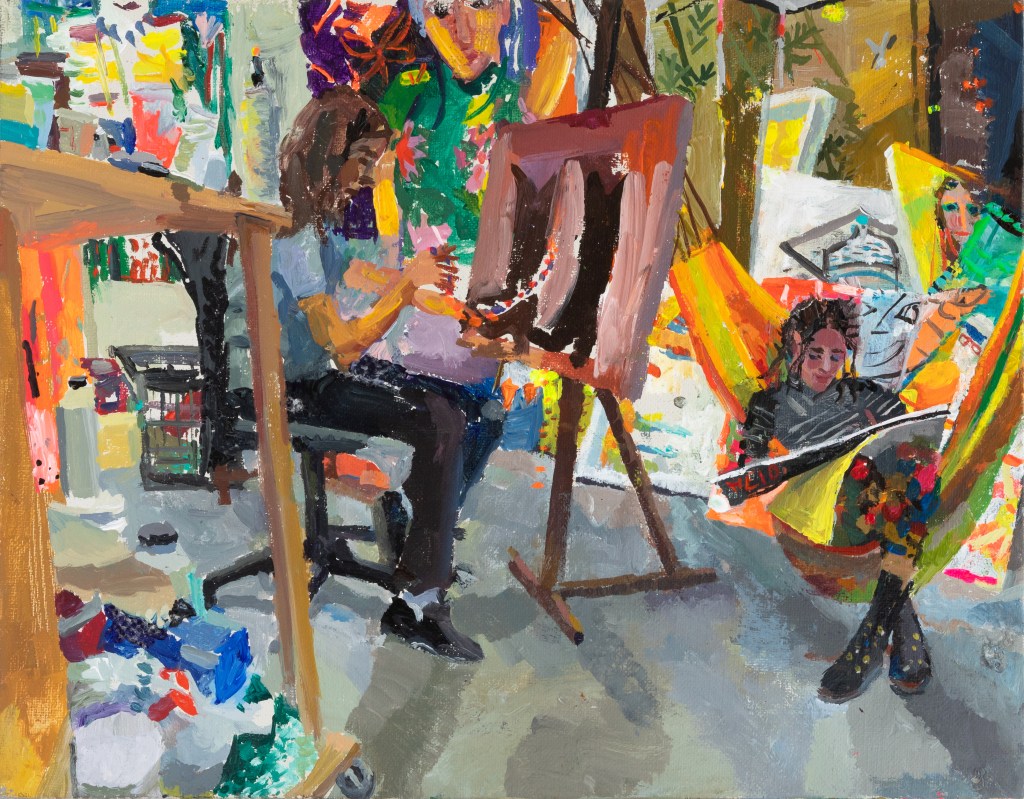
Contributed by Sangram Majumdar / In 2015 Susanna Coffey saw �In the Studio: Paintings,� an exhibition of canvases from the 1600s to the present that John Elderfield curated at Gagosian. Susanna was struck by the fact that the exhibition only included three paintings of women, and so she decided to make a series that focuses exclusively on female artists. She created two distinct bodies of work � portraits of artists working in their studios and, in her own studio, nocturnal self-portraits. Recently we had a conversation about the work, which is on view at Steven Harvey Fine Arts through December 22. �One of the great things about the studio,� Susanna told me, �is how we disappear into ourselves.�
Sangram Majumdar: I remember a few years ago we were looking at those night paintings in your studio and you showed me the painting that you had done of Joan Waltemath. Looking at your new exhibition of paintings “In Her Studio” at Steven Harvey Fine Art Projects, this project seems to go back almost four years. What made you interested in painting artists in their studios?
Susanna Coffey: It began in a very clear way. In 2015 there was the show “In The Studio: Paintings” curated by John Elderfield at Gagosian and it was paintings from the 1600s to the present. It was a terrific show. But there were maybe three women in the whole show. And so I said, “Oh well that’s something to do.” I loved that show, but it was like, “Well, there’s some room here around the subject of “A Room of One’s Own”.”
SM: How did you start?
SC: I started with people I knew. And so I’ve been working on that for the last four years, not every day, but off and on when people would allow me to sit in a corner of their studio and paint. And the point wasn’t painting a portrait in the conventional sense, but rather painting them in as they were in their work. People’s time in a studio is so precious. I wanted them to continue to work, and I just wanted to paint what I see. These are people I like and admire, people with whom I don’t get enough time.
My interest is the kind of portraiture, like Degas’s paintings of working women. I love that idea. That aspect of Degas� work, appealed to me, to show women in their places of work. And when I saw the Gagosian show I thought, oh yeah, well I guess there need to be more paintings of women at work in their studios, and how important the studio is, how in a way, it’s a sacred space.

SM: Do you think of these as a new set of documents? Perhaps they are both contemporary additions and a counter measure alongside those other historical works?
SC: Definitely a filling of a blank space. I was interested in witnessing and accounting for what and how I see which is very piece to piece to piece. I let my eyes work their way around the studio in a slow and un-directed way and I don’t have plans right before I begin painting.
SM: Is this un-directed way of seeing also a broader way of making connections in your work? How do the interiors at night relate to the other paintings in the exhibition?
SC: That was a segue from the night landscape paintings I was making last winter. I was working on the show (and book) “Night Painting at the Milton Art Bank” in Milton, PA. It had become too cold to paint outside and I was looking for a way to paint at night but in the studio. Then I realized I could paint myself in the studio in the way I had in others’ studios. Also, at that time I had some much older works, from the 80’s around the studio. It was fun to include them in the new paintings.
SM: Do you think of these as self-portraits?
SC: I don’t think about myself when I’m painting. I’m interested in hanging around the studio and I was just interested in including something of my past. Even though I’m painting myself in a mirror, the focus is on a shadow or images in a painting. because one of the great things about the studio is how we disappear to ourselves.
SM: In many of your paintings the bodies merge with the space, camouflaging them, making them part of the image.
SC: Well, I’m just interested in that way of seeing, where the field of vision is a situation of great equality. Visuality is an experience of evenness. I really enjoy seeing from piece to piece as I move across both a room and over my panel or canvas. At the end, there are figurative signifiers, but I’m not focusing on them as I paint, just going through shape to shape to shape and not seeing anything other than shapes and colors and edges. And that’s the kind of painting I love to do.
SM: That seems to be especially true in Heidi Howard and Esteban Cabeza de Baca in Heidi Howard’s Studio 11/3/19. Moving left to right in that painting feels like my eyes moving across a tapestry. It also seems to foresee the paintings where you are in front of projections. What gave you the idea to do them?
SC: In the paintings that were painted in the dark using projections, I was just thinking how much I owe to other painters. Ones who freed me or have influenced me so much. Oh, it’s as if they’re always with me as I’m working; Tintoretto, Bob Thompson, El Greco. I just submerged myself in the projection of their painting. That’s what I feel like when I’m in studio, like I’m inside all of the works of all of these people whom I admire and who have helped me in my own work, sustained my efforts.

SM: In looking at your paintings I don’t feel the burden of history ever. Whether it’s five years old or 500 years old, the paintings are alive if they are alive to the artist. And I feel like these paintings of yours are full of joy and life.
SC: Oh yes, what Herbert Marcuse says in Eros and Civilization, is that �the aesthetic dimension is destructive of time in the way that time is destructive of lasting gratification.” So, I can look at a painting or cave drawing or something that might be thousands of years old but time hasn’t destroyed its ability to gratify, to carry meaning. I feel so strongly connected with the history of painting and as I get older, I love it more and more. So, being covered all over by somebody else’s painting. It’s just so much fun.
SM: And that seems to be also what’s similar in what you’re doing in the night interiors as well as the paintings in other artists’ studios. In both cases you’re communing with another person’s physical and mental space.
SC: I’m in their spiritual space, their space of creation. It’s such a privilege to be there. I’m very thankful that people let me do that, because you’re in their thing. I want to keep doing it. I�d like to continue this project for a long time.
SM: Two of my favorite paintings are also two of yours it seems. Tintoretto’s Susanna and the Elders and El Greco’s Laoco�n.
SC: How much do I love that Tintoretto? And the Susanna and the Elders painting has always been important to me for many reasons. It�s really is a “me too” painting. Tintoretto really got the creepiness of those elders. Formally, its spatiality and scale changes are so dramatic, as dramatic as its subject. I’ve always appreciated his treatment of the motif apart from the formal stuff, because of course in my generation perpetrators were not reviled in any way or seen as abject and disgusting. It was just “that’s what men do.” That painting, I always felt comforted by it.
SM: In your painting, you’re standing and are surrounded by your namesake character. Susanna in the real, twice.
SC: I wanted to stand between them and her.
SM: And the meeting of the wall and floor creates a line, an arrow that runs right into the head of the male figure. He’s even more shoved in the corner. I love that.
SC: Yes. That was real, because the light was just there on my floor.
SM: So how has the show, now that it’s up, changed how you’re thinking about the project?
SC: Well, now I have ideas for other situations, other kinds of studios and or creative workplaces. I also want to do a book that includes the work of the artists I visit and writings about the subject of women�s workplaces and about this time in history when women actually have places, have rooms. I mean we can take for granted the last 20 years, but I really do not. I really know that it was very different a very short time ago. I think history is changing in regards to the place of gendering in all societies.
SM: These paintings feel like a reminder that artists, the act of making, and the work itself, none of it is a solitary enterprise.
SC: I like to think that it’s a way for me to travel. And travel to people I know. You do too. I mean, we love these artists.
“Susanna Coffey: In Her Studio,” Steven Harvey Fine Art Projects, New York, NY. Through December 22, 2019.
About the author: Born in Kolkata, India, Sangram Majumdar is a Professor of Painting at the Maryland Institute College of Art. In April 2019, his solo exhibition �once, and twice� was on view at Geary Contemporary in NYC.
NOTE: Today we have less than two weeks remaining in the 2019 Two Coats of Paint year-end fundraising campaign. If you value what we do at Two Coats of Paint, please consider supporting the project for another year. Thanks in advance for your tax-deductible contributions, and heartfelt gratitude to those readers who have already contributed. Please click here to contribute.
Related posts:
Sangram Majumdar�s super power
An ocean of rivers: Esteban Cabeza de Baca
Interview: Victoria Roth at Brennan & Griffin
Carolanna Parlato�s sporting informe

















After reading this engaging conversation I had to see the show, and was further astounded by the deep vistas opened in the intimate space of this practice.
Great stuff
I love your work- I bought a black and white self portrait years ago at Sag Harbour, Staten Island.
jb